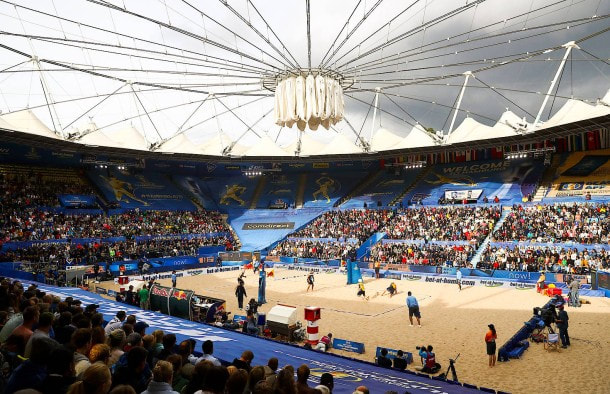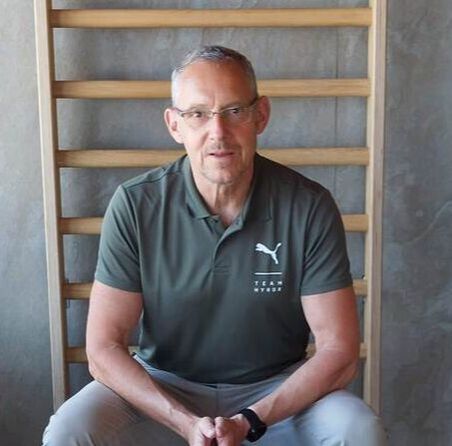|
I have already dealt with this topic in the last course with my students: Fitness, is the fastest growing "sport" in the world. despite the COVID pandemic. The demand for fitness is not only for gyms, fitness studios, CrossFit boxes, micro,- or yoga studios. Fitness competitions are becoming more and more popular. Although there has been a slight dip in participation rates due to COVID in 2020 and 2021; most competition formats have come out of the crisis in good shape. Whether Crossfit Games, Spatan Race, Mudder Games or other OCRs.
One competition format that has established itself in recent years - not only in Germany but throughout Europe - is HYROX. The target group are the millions of worldwide athletes who call Functional Fitness their sport. Up to now, there have hardly been any comparable, measurable fitness events for everyone. HYROX, that is the ultimate challenge: A perfect combination of strength, endurance and speed, for all performance and age groups! I have been following the event since 2019, when I listened to a podcast with one of the founders of the fitness series, Moritz Fürste, Germany's most successful hockey player. Fürste was able to explain the motivation and concept of the event in the sports business talk and convinced me not only from a business point of view. Since I have a background in athletics - both as an athlete and coach - I fully understand the concept of 8x 1km running in combination with 8 workouts. Inspired by the talk and the concept, I started training with the goal of completing a HYROX competition myself in April 2020. Due to Corona, of course, that didn't happen for a while, but in September and November 2021 competition was calling: I started in Leipzig and Berlin! Having an idea and a concept is certainly one thing, but to successfully put such a concept into practice a completely different one! HYROX or better, the company UpsolutSports GmbH from Hamburg, which is behind the concept, has succeeded greatly! It was a great experience and I had the opportunity - besides the races - to chat to some other athletes and officials. Great success for the event - at least the two events I competed in. This winter 2022/23 HYROX starts into its 4th season. The DACH (Germany, Austria and Switzerland) countries are the core of the event calendar, so are Spain, Netherlands and the UK. Even in the USA, the largest fitness market in the world, there have already been a number of successful events. Chicago, Dallas, New York or Las Vegas. All first-class organized events, which find more and more enthusiasts. I will also also participating again this season and have booked my tickets for two events initially. More to come maybe in 2023. In addition to the sporting side, HYROX remains a very interesting research object as a business case in the field of fitness events. 12/3/2021 Keine WM in Katar?Die Luft wird dünner für die Organisatoren der FIFA Fußball-Weltmeisterschaft 2022 in Katar. In gut 20 Monaten soll im Emirat am Arabischen Golf der Ball rollen, die erste Fußball-Weltmeisterschaft in einem arabischen Land.
Doch auf Grund der Menschenrechts-Situation und der Arbeitsbedingungen der ausländischen Arbeiter, mehren sich die Stimmen, die zu einem Boykott der WM aufrufen. In Norwegen sprechen sich etliche Fußballvereine dafür aus, darunter Rosenborg Trondheim, der bekannteste. Auch in Frankreich und den Niederlanden nimmt die Debatte an Fahrt auf. In Deutschland vernetzen sich Fans, Aktivisten und Wissenschaftler im Netzwerk Boycott Qatar. Diese Woche eine weitere Meldung zu dem Thema. Der renommierte niederländische Sportrasenhersteller Hendriks Graszoden wird keinen Rasen für die WM 2022 in Katar liefern – unter anderem wegen besagter Menschenrechtsverletzungen. Der britische Guardian berichtete vergangenen Monat, das rund 6.500 Arbeiter in den vergangenen 10 Jahren - seit der Vergabe der WM nach Katar - auf den Baustellen zu Tode gekommen sind. In einem Artikel in ZEIT ONLINE beleuchtet der freie Journalist Ronny Blaschke die Situation. HIER geht es zum Artikel. Die Fußball-WM in Katar und die Sportpolitik des Landes wird im Sommersemester 2021 auch Thema meiner Seminare "Strategisches Management" und "Eventmanagement im Sport" sein. Wir werden uns u.a. kritisch mit der Veranstaltung und der Vergabe beschäftigen und einen Blick auf das Konzept des LOCs werfen, die Idee hinter der Bewerbung und Möglichkeiten erörtern, wie auf eine Verbesserung der Situation der Menschenrechte Einfluss genommen werden kann. Anlässlich des Weltfrauentages in diesem Jahr hat die englische BBC wieder ihre Umfrageergebnisse zum Thema "Preisgelder im Sport" veröffentlicht.
Laut der BBC Studie, die seit 2014 durchgeführt wird, bietet die überwältigende Mehrheit des Sports nun gleiches Preisgeld für Männer und Frauen bei den Top-Events rund um den Globus. Von den 48 befragten Sportarten boten 37 Sportarten Preisgelder an , von denen nur drei bei keiner ihrer großen Meisterschaften oder Veranstaltungen gleiche Preisgelder auslobten. Die größten Preisgeldlücken für männliche und weibliche Athleten gibt es im Fußball, Golf und Basketball. Für England gesprochen, ist Sportminister Nigel Huddleston zufrieden mit der Entwicklung. "Es ist absolut richtig, dass die Prämien nun übereinstimmen und wir in den letzten Jahren auch eine deutliche Steigerung der Preisgelder im Frauensport gesehen haben." Seit der letzten Ausgabe des BBC-Studie zum Thema Preisgeld im Sport, im Jahr 2017 haben Sportarten wie Hockey, Klippentauchen, Surfen und Ringen bei mindestens einem großen Wettbewerb die Parität der Prämien erreicht. Die eher als konservativ geltende Sportart Cricket hat hier die größten Schritte unternommen, um den Abstand zu verringern. Es ist das dritte Mal, dass BBC Sport diese globale Studie nach 2014 und 2017 durchführt. Die 2021er Ausgabe konzentriert sich auf das Preisgeld, das an die Gewinner des Wettbewerbs vergeben wird, und beinhaltet keine Löhne, Boni oder Sponsoring. Zu beachten ist, das einige Sportarten, einschließlich Rugby Union und Rudern, Männern und Frauen bei großen Wettkämpfen keine Preisgelder ausloben. Den Artikel und die Gesamtübersicht aller Sportarten findet man hier Eine veränderte Erwartungshaltung und neue Herausforderungen bei der Ausrichtung von Sportgroßveranstaltungen erfordern ein strategisch ausgerichtetes Handeln. Die Nationale Strategie Sportgroßveranstaltungen schafft die Grundlage, den spezifischen Anforderungen gerecht zu werden.
Sport ist in Deutschland fest im Alltag integriert. Vom bewegten Kindergarten bis zum Seniorensport, vom Freizeit- bis zum Leistungssport und vom Fernseher bis zur "Fanmeile": Sport bewegt und Sport begeistert. Besondere Begeisterung können Sportgroßveranstaltungen im Land entfachen. Entweder durch herausragende sportliche Leistungen wie Usain Bolts Weltrekordlauf und Robert Hartings Sieg im Diskuswerfen bei der Leichtathletik-WM 2009 im Berliner Olympiastadion oder durch die Dynamik, die eine Veranstaltung selbst entwickeln kann. So ist das "Sommermärchen" der Fußball WM 2006 bis heute tief im kollektiven Gedächtnis verankert und zeigt beispielhaft, dass Sportgroßveranstaltungen ein Gestaltungspotenzial haben, das weit über die Grenzen des Sports hinausgehen kann. Wie nur wenige anderen Ereignisse, können sie ganze Nationen nach innen vereinen und nach außen positiv repräsentieren. Durch die Förderung von Vielfalt, Integration, Teilhabe und Inklusion können sie das gesellschaftliche Miteinander verbessern und hohe mediale Aufmerksamkeit kann dazu beitragen, dass sie als Katalysator für nationale und internationale Nachhaltigkeitsziele wirken. Daher begrüßt die Bundesregierung grundsätzlich deutsche Bewerbungen um Sportgroßveranstaltungen und schaut erwartungsvoll auf die kommenden Jahre, in denen man sich wieder als großartiger Gastgeber präsentieren kann, z.B. bei den European Championships 2022, den Special Olympics World Games 2023 oder der UEFA EURO 2024. Im Mai 2020 hat die "AG Evaluation von SGV" unter der Leitung von Prof. Dr. Holger Preuss (Mainz) die Arbeit aufgenommen. Ich freue mich nicht nur auf Grund meiner persönlichen Erfahrungen zum Thema Sportevents meinen Beitrag leisten zu dürfen, sondern freue mich auch auf den Austausch mit internationalen Experten und Wissenschaftlern aus Deutschland, Österreich und der Schweiz die zum Thema in den vergangenen Jahren geforscht haben und über ein profundes Wissen auf ihrem Gebiet verfügen. |
AutorRalf Iwan MBA Archiv
June 2024
Kategorien/ Categories
All
|






 RSS Feed
RSS Feed

6/9/2022
0 Comments